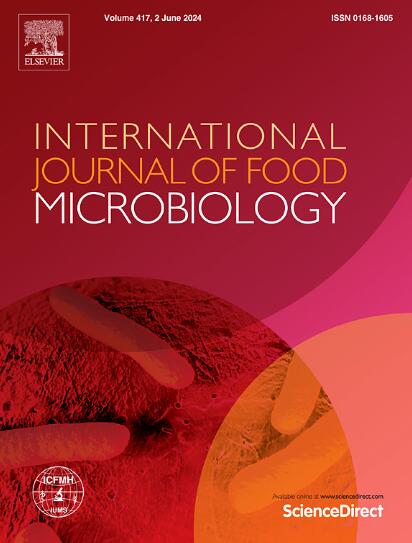BCP4:一种对米粥中蜡样芽孢杆菌有有效抑制作用的新型抗菌肽。
IF 5
1区 农林科学
Q1 FOOD SCIENCE & TECHNOLOGY
International journal of food microbiology
Pub Date : 2025-02-02
DOI:10.1016/j.ijfoodmicro.2024.111001
引用次数: 0
摘要
蜡样芽孢杆菌是一种常见的食源性病原体,经常污染大米产品并产生蜡样毒素,对食品安全和人类健康构成重大风险。相比之下,枯草芽孢杆菌是抗菌肽(AMPs)的一个有前途的来源。本研究利用枯草芽孢杆菌发酵虾粪,发现了一种名为BCP4 (KGKTLLQ)的新型AMP,推测BCP4可能是由虾粪中天然存在的内源酶催化酶解产生的。BCP4对蜡样芽孢杆菌具有较强的抑菌活性,最低抑菌浓度(MBC)为62.5 μg/mL,抑菌时间为3 h,其抑菌效果超过了常用的微生物源AMP nisin (500 μg/mL)。BCP4通过破坏细菌细胞壁和细胞膜来起作用,从而使细胞内的物质流出。BCP4还能穿透细胞膜并与DNA结合,有效地对细菌进行杀菌。同时,用哺乳动物红细胞处理BCP4显示其无溶血作用。BCP4浓度为62.5 μg/mL时,能显著抑制米粥中蜡样芽孢杆菌的生长。本研究为利用BCP4防治蜡样芽孢杆菌污染提供了理论依据。本文章由计算机程序翻译,如有差异,请以英文原文为准。
BCP4: A novel antimicrobial peptide with potent efficacy against Bacillus cereus in rice porridge
Bacillus cereus is a common foodborne pathogen that frequently contaminates rice products and produces cereulide toxins, presenting a significant risk to food safety and human health. In contrast, Bacillus subtilis is a promising source of antimicrobial peptides (AMPs). In this research, a novel AMP named BCP4 (KGKTLLQ) was discovered through the fermentation of shrimp waste with B. subtilis, which speculated that BCP4 might be generated through enzymatic hydrolysis catalyzed by endogenous enzymes naturally present in shrimp waste. BCP4 demonstrated potent antibacterial activity against B. cereus with a minimum bactericidal concentration (MBC) of 62.5 μg/mL and bacterial time-kill of 3 h. BCP4 surpassed the bactericidal efficiency of nisin (500 μg/mL), a commonly used AMP of microbial origin. BCP4 operates by causing damage to the bacterial cell wall and membrane, which allows the contents of the cell to flow out. BCP4 also penetrates the cell membrane and binds with DNA, effectively sterilizing the bacteria. Meanwhile, treatment of BCP4 with mammalian red blood cells revealed that it was nonhemolytic. Furthermore, the growth of B. cereus in rice porridge was significantly inhibited by BCP4 at a concentration of 62.5 μg/mL. This study provides a theoretical basis for using BCP4 to control B. cereus contamination.
求助全文
通过发布文献求助,成功后即可免费获取论文全文。
去求助
来源期刊
CiteScore
10.40
自引率
5.60%
发文量
322
审稿时长
65 days
期刊介绍:
The International Journal of Food Microbiology publishes papers dealing with all aspects of food microbiology. Articles must present information that is novel, has high impact and interest, and is of high scientific quality. They should provide scientific or technological advancement in the specific field of interest of the journal and enhance its strong international reputation. Preliminary or confirmatory results as well as contributions not strictly related to food microbiology will not be considered for publication.

 求助内容:
求助内容: 应助结果提醒方式:
应助结果提醒方式:


